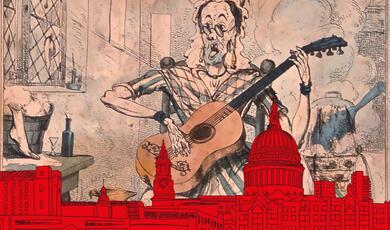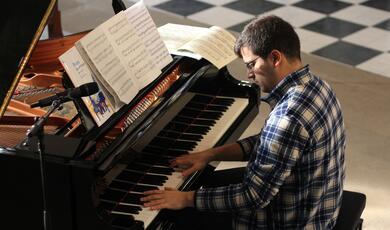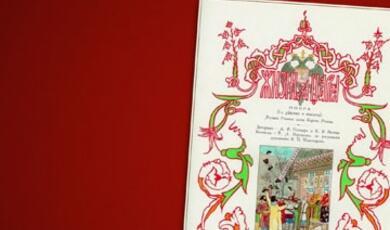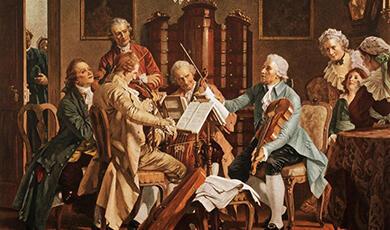Love and Music
Share
- Details
- Text
- Audio
- Downloads
- Extra Reading
Tristan & Isolde, Romeo & Juliet, Pelléas & Mélisande are three pairs of lovers who have fired composers’ imaginations. Films like Love Story, Love Actually, and Shakespeare in Love are made all the more poignant by their musical scores. And where would The Beatles, 10cc, or Queen have been without All you need is love,I’m not in love, and Love of my life?
This lecture shows how there is no emotion more likely to inspire musical creativity than love.
Download Text
Dating from around 2,000 BCE, a Mesopotamian poem in Sumerian – the ‘Love- Song of Shu-Sin’ [King of Ur] – is the world’s oldest surviving love-song. Its music doesn’t survive. The Bible’s Song of Songs possibly dates from the 3rd century BCE and no music survives that might have been associated with its original Hebrew text, although many musical settings of passages of the Song of Songs (Canticum Canticorum in Latin) have been composed over the last half millennium, not least by Palestrina, Schütz, Purcell, and Vaughan Williams (whose 150th anniversary of birth falls this year). The songs of the Troubadours and Trouvères in medieval France, and the work of the Minnesingers (‘love singers’) in the language of Middle High German – and later the work of the Meistersingers (‘mastersingers’) – are well-preserved repertories of medieval love songs.
The late-12th century poem, Tristan und Iseult, by the Alsatian Gottfried von Strassburg, is a chivalric romance; it became the basis of Richard Wagner’s 1850s music drama, Tristan und Isolde. The opening musical phrase of Wagner’s opera (a term that Wagner himself never applied to Tristan) has become a staple element in the discussion of 19th-century music. The first chord of the Prelude (known by Wagner as Liebestod) is known as the ‘Tristan chord’. The three notes that precede it form the ‘Grief-motif’, and the Tristan chord begins the ‘Longing-motif’. Over several hours of through-composed music, the story unfolds. Tristan, a Cornish knight, travels to Ireland to escort Princess Isolde to Cornwall so that she may marry Tristan’s uncle, King Mark. On the journey to England, Tristan and Isolde drink a love-potion (thinking it the elixir of death – Tristan had killed Isolde’s previous fiancé and wishes to atone, whereas Isolde simply wishes to end her miserable existence). The pair’s adulterous relationship ensues, and Tristan is mortally wounded by one of King Mark’s soldiers. Tristan sails to Brittany where Isolde joins him as he expires. While often referred to as the Liebestod (‘Love-Death’, so named by the composer Franz Liszt), this climax was referred to by Wagner himself as Verklärung (‘Transfiguration’). The composer Gerard McBurney refers to the final scene of Wagner’s Tristan und Isolde as a synesthetic experience on a grand scale. Tristan’s blood flows from his body and the smell of the blood becomes floral to Isolde. Isolde feels flowers embracing her body and the flowers become melody. Smell, hearing, sight, and touch combine so that one can physically taste Wagner’s Gesamtkunstwerk (‘total artwork’).
On a smaller scale, Wagner wrote the Siegfried Idyll (a symphonic poem for chamber orchestra) as a birthday present to his second wife in 1870, upon the birth of their son Siegfried. Small-scale the instrumental forces may be (and they had to be in order to fit the 13 players onto the stairs of the Wagners’ villa in Lucerne), but the gesture was large scale. Wagner claimed that he conceived the main theme six years earlier, while Wagner and Cosima von Bülow (née Liszt – daughter of the composer Franz Liszt and married to the conductor Hans von Bülow) ‘consummated their relationship’. In the event, Wagner seems to have been over-stating the case and the theme seems to have been devised not in the summer of 1864 but in the autumn of that year, while Wagner was on his own and not with Cosima at all. But that’s not such a good love story Claude Debussy, like any European composer growing up in the late-19th century, was captivated by the music of Wagner. An obvious example is the beginning of Debussy’s song cycle Fêtes galantes (Courtship parties). In 1882 ‘En sourdine’ (‘Muted’) appeared second in the cycle and began with a Debussyan trademark chord of the 9th (‘Let this calm twilight penetrate our love with deep quiet’). The song was written for Debussy’s first love, a married amateur Soprano called Marie-Blanche Vasnier. Marie-Blanche was 16 years her husband’s junior and 14 years older than the 18-year old Debussy. During their affair, Debussy wrote the captivatingly green-eyed redhead more than 20 songs. Of Fêtes galantes, Debussy wrote: ‘To Madame Vasnier, these songs, conceived by your memory, can only belong to you, as their composer belongs to you’. By its second version in 1891 ‘En sourdine’ opened the cycle, but the dedication had been changed to Miss Catherine Stevens (with whom Debussy was by then in love) and the opening chord had become Wagner’s ‘Tristan chord’, transposed up an octave. When the song was published in 1903, it had been re-dedicated to the wife of Robert Godet. Godet was one of Debussy’s oldest and most faithful friends – amongst other things they had shared an initial love of Wagner’s music-drama Parsifal. Debussy struggled with Wagner’s pervasive influence, and Debussy began actively to set about ridding his music of Wagner’s arch-romantic German style. Debussy would rip up pages of his own music in a physical attempt to rid himself of the ‘Ghost of Old Klingsor’, as he referred to Wagner (Klingsor is the magician in Parsifal). And in the final movement of Debussy’s Children’s Corner Suite (published in 1908) Debussy cruelly parodied the opening of Wagner’s Tristan und Isolde – Debussy mockingly asks the pianist to play ‘with great emotion’. Debussy jazzes up the ‘Tristan chord’ itself and follows it with a musical cackle of derisive laughter. The gesture is then repeated, just in case the object of Debussy’s spite has not been properly appreciated. Wagner’s love story is entirely demeaned by Debussy, served up as piano music fit to be performed by a child, and dedicated to Debussy’s three-year old daughter. Debussy’s complicated response to Wagner’s music was perhaps the very definition of a love-hate relationship.
Of all Shakespeare’s plays, Romeo & Juliet – a story of star-crossed lovers – is the one that has inspired more love-inspired music than any other. From Hector Berlioz’s choral symphony of the late 1830s (inspired by seeing Anglo-Irish actress Harriet Smithson on stage as Juliet in Paris a decade earlier) and Tchaikovsky’s late-19th century fantasy-overture, to Serge Prokofiev’s mid-20th century ballet and Bernstein’s spin-off West Side Story set in mid-1950s New York, the heartstrings of the listener are tugged every which way. Similarly ending with the death of both of the lovers, the symbolist play Pelléas et Mélisande of the early-1890s by the Belgian author Maurice Maeterlinck quickly became the basis for a number of musical settings composed over the next decade and a half. First was Gabriel Fauré’s incidental music for an 1898 English language production of the play in London. Claude Debussy had been approached for the London project first but turned the commission down on the grounds that he was already too busy adapting the play into an opera. Debussy’s opera was premièred in Paris in early 1902 at around the time that the Austrian composer Arnold Schoenberg began work on his own symphonic poem for large orchestra. Richard Strauss suggested the subject matter to Schoenberg, but neither seemed aware of the existence of Debussy’s new opera. Within three years, Jean Sibelius had composed incidental music for a Swedish-language production of the play at the Swedish Theatre in Helsinki.
The list of film scores concerned with depicting love is a long one. The Hollywood classic Love Story was shunned by leading actors Jeff and Beau Bridges, Michael Douglas, Jon Voight, and Michael Yorke. Ryan O’Neal eventually played opposite Ali MacGraw and the film’s main musical theme, by the late Francis Lai, won the French composer a well-earned Oscar. 50 years later, not only does the Love Story tune remain close to the public’s heart, but the melody’s opening interval has become an educational tool in identifying the interval of a descending Minor 6th. Shakespeare in Love also earned its composer, Stephen Warbeck, an Oscar at the Academy Awards in 1999. Marc Norman’s story fictionalises Shakespeare falling in love while writing Romeo and Ethel and Warbeck’s score integrates modern and period musical instruments. The music for Shakespeare in Love is a far cry from the ostentatiously star-studded montage of songs that comprises the score of Love Actually. Hits by The Beach Boys, Mariah Carey, Otis Redding, Eva Cassidy, Joni Mitchell, Norah Jones, Phil Collins and many others are woven together by a beguilingly memorable original soundtrack composed by Craig Armstrong for this 2003 modern classic. An uncomfortable truth for the creators of movies is that the score is important not just to support the action within the film itself, but thereafter as a recognition trigger.
Of almost 200 songs by The Beatles, only 16 have the words ‘love’, ‘loves’, or ‘loving’ in the title. Of these, one preceded the Parlophone/Apple discography (‘Hallelujah, I love her so’ – a 1960 McCartney drumless cover of Eddie Cochran’s version of Ray Charles’s 1956 R&B release), two of which (‘Solider of love’ by Buzz Cason & Tony Moon and Phil Spector’s ‘To know her is to love her’) were recorded for the BBC Light Programme’s three-part series Pop Go The Beatles in 1963, and another of which, ‘Step inside love’, was a bossa nova busked between Abbey Road takes in 1968, a song which Paul McCartney had written as the signature tune for Cilla Black’s first television series. Of the well-known Beatles ‘Love(s)(ing) songs’, the better known are ‘P.S. I love you’ (1962), ‘All my loving’ and ‘She loves you’ (1963), and ‘Can’t buy me love’, ‘And I love her’, and ‘Love me do’ (1964). All of which are knocked into a cocked hat by the non-album single ‘All you need is love’, which came straight out of 1967’s ‘Summer of Love’. My high opinion of ‘All you need is love’ should, however, be tempered by that of, for instance, Ian MacDonald, who wrote that ‘its inspiration is desultory’, a result of ‘drug-sodden laziness’, culminating in ‘wilfully substandard work’. ‘All you need is love’ was premièred via a satellite link to 400 million people. When the song was released as a single a few days later, it leapt to the top of the charts in both the UK and the US.
Falling right into my own (1975, age of 14) reminiscence bump [see my Gresham Lecture Nostalgia & Music of 16 September 2021], 10cc’s ‘I’m not in love’ had to fight hard to be released at all. ‘I’m not in love’ was originally written as a guitar- based bossa nova composed mostly by Eric Stewart with some input from Graham Gouldman (the introduction, the bridge, and some re-harmonisation of the melody). The other two band members (Kevin Godley and Laurence Creme) had a visceral aversion to the song, and the bossa version was erased; no recording of it survives. But because office staff carried on singing the song after its cancellation by Godley and Creme, it was resurrected, but with a ‘wall of sound’ vocal backing as conceived by Kevin Godley. Lol Creme suggested using tape loops – the influence of The Beatles’s ‘Revolution 9’ of seven years earlier is clear – to sustain the band members’ chromatic vocalisations: one of the late-20th century’s iconic pop songs was born; it reached number 1 in the UK charts and number 2 in the US. The 10cc’s secretary, Kathy Redfern, was persuaded to whisper the words ‘Be quiet, big boys don’t cry’ to cover for a lack of convincing material at one point. Most touchingly, in spite of the way that the lyrics might superficially read, this is a love song written for Eric Stewart’s wife Gloria. At the time the couple had been married for nine years. Now it has been 55; it turns out that they are in love.
Another heterosexually influenced 1975 song was Queen’s ‘Love of my life’. The ballad was written by Freddie Mercury for Mary Austin, whom Mercury met in 1969. Freddie became engaged to Mary in 1973, and the engagement stayed afloat through the next three years before foundering – Mercury was famously gay but never actually came out publicly (there was no real need by the late-1970s; it was obvious). While Austin and Mercury never married, Mercury said of Austin that ‘to me she was my common-law wife; to me it was marriage’. Moreover, Freddie said: ‘I couldn’t fall in love with a man the same way I have with Mary. All my [male] lovers asked me why they couldn’t replace Mary, but it’s simply impossible’. In spite of this seemingly incontrovertible evidence that ‘Love of my life’ was written for Mary Austin, it has been asserted by some that the ballad was written for the man for whom Mercury left Austin. Ultimately Mary was granted possession of Freddie’s cremated ashes when he died in 1991 at the age of 45; Mary also inherited half of Freddie’s estate. Clearly the song was written for her.
Composers often have colourful biographies and, in particular, they often have colourful love lives. Perhaps that is why prospective fathers-in-law often seem frequently to object to the idea of their daughters marrying musicians. Edward Elgar was given a poem by one of his piano pupils, Alice Roberts, who was almost nine years the composer’s senior. Elgar duly set ‘The Wind at Dawn’ to music and followed it up with a piece for violin and piano, ‘Salut d’amour’ (‘Love’s Greeting’), which he offered to Alice as an engagement present. Alice was thereafter disinherited by her family. By contrast, Robert Schumann was nine years older than his intended – the 18-year-old pianist Clara Wieck. Kreisleriana (an eight-movement composition for solo piano) was composed by Schumann in just four days, when the couple were deliriously in love. Schumann wrote that ‘I want to dedicate it to you – yes, to you and nobody else – and then you will smile so sweetly when you discover yourself in it’. However, Clara’s father, Friedrich, was strongly opposed to their union and the matter was taken to court. In the event, Robert and Clara won the case and were married the day before Clara’s 21st birthday on 12 September 1840. (Kreisleriana was ultimately dedicated to the Polish composer and virtuoso pianist Frédéric Chopin, who seems not to have rated it). After her husband’s breakdown and eventual demise, Clara Schumann became ever closer to the much younger composer Johannes Brahms. However, much they were in love with each other, they never consummated their relationship, far less contemplated marriage. Brahms wrote his Six [Piano] Pieces, op. 118 for Clara – the second of which is the achingly beautiful Intermezzo in A – and within four years they were both dead: they died within a year of each other; Clara first.
Music has been offered as many a love token over the years. Gustav Mahler wrote the Adagietto of his 5th Symphony for Alma Schindler, whom he was soon to marry. And in a move that might have been considered heavy-handed even in 1902, Mahler requested that Alma cease composing after they were wed. The Czech composer Leoš Janáček gave the name ‘Intimate Letters’ to his 2nd String Quartet, which he wrote for Kamila Stösslová, a married woman 38 years Janáček’s junior. Kamila and Leoš exchanged more than 700 letters over a decade, and in the last year of Janáček’s life, 1928, the composer wrote to Stösslová practically daily. Of his 2nd String Quartet, he wrote to Kamila that she was ‘behind every note, you, living, forceful, loving. The fragrance of your body, the glow of your kisses – no, really of mine. Those notes of mine kiss all of you. They call for you passionately.’ A few months later, Janáček died with Stösslová at his side. At the other end of the spectrum, Benjamin Britten wrote the Seven Sonnets of Michelangelo near the beginning of his relationship with the singer Peter Pears. It was the first music that Ben wrote specifically for Peter to sing, and each of the seven songs deals with an aspect of love. Interestingly, for all the shared experiences between the pianist (Britten) and the singer (Pears), the piano finishes the last song of the cycle without the voice – the composer has the final say. In life, it was the other way around: Sir Peter Pears survived Lord Britten by almost ten years.
© Professor Summerly 2022
Further Listening
Ted Gioia Love Songs – The Hidden History (OUP, 2015).
Ian MacDonald Revolution in the Head – The Beatles Records and The Sixties, 2nd revised edition (Vintage, 2008).
François Lesure & Roger Nichols (ed.) Debussy’s Letters (Faber & Faber, 1987).
NOW That’s what I call Love Songs (EMI CD 354 228, 2013).
The Beatles Anthology 3 vols: Historic Recordings 1958-64; Dash & Daring 1965-68; Final Years 1967-70 (Apple Records 8 34445 2, 8 34448 2, 8 34451 2, 1995-96).
Richard Wagner Tristan und Isolde Berlin Philharmonic Orchestra / Herbert von Karajan 4CDs (EMI, 1972; PLG UK Classics, 2016).
Further Listening
Ted Gioia Love Songs – The Hidden History (OUP, 2015).
Ian MacDonald Revolution in the Head – The Beatles Records and The Sixties, 2nd revised edition (Vintage, 2008).
François Lesure & Roger Nichols (ed.) Debussy’s Letters (Faber & Faber, 1987).
NOW That’s what I call Love Songs (EMI CD 354 228, 2013).
The Beatles Anthology 3 vols: Historic Recordings 1958-64; Dash & Daring 1965-68; Final Years 1967-70 (Apple Records 8 34445 2, 8 34448 2, 8 34451 2, 1995-96).
Richard Wagner Tristan und Isolde Berlin Philharmonic Orchestra / Herbert von Karajan 4CDs (EMI, 1972; PLG UK Classics, 2016).
Part of:
This event was on Thu, 27 Jan 2022
Support Gresham
Gresham College has offered an outstanding education to the public free of charge for over 400 years. Today, Gresham College plays an important role in fostering a love of learning and a greater understanding of ourselves and the world around us. Your donation will help to widen our reach and to broaden our audience, allowing more people to benefit from a high-quality education from some of the brightest minds.


 Login
Login







